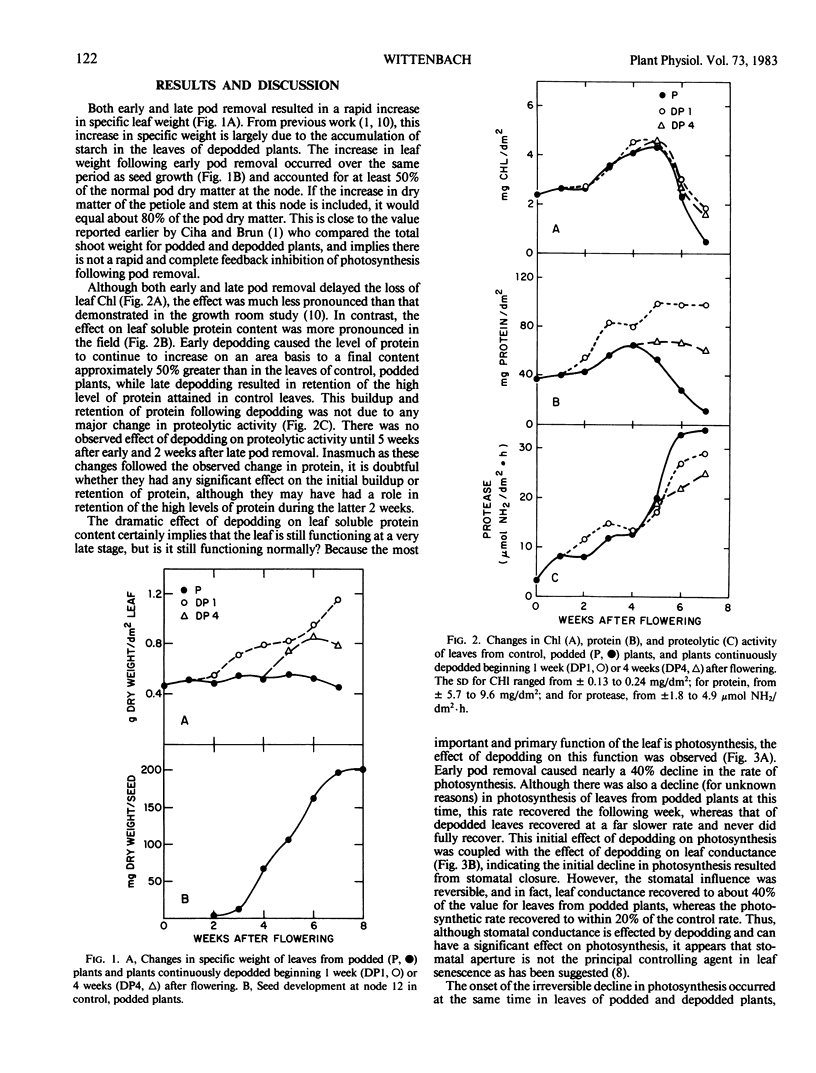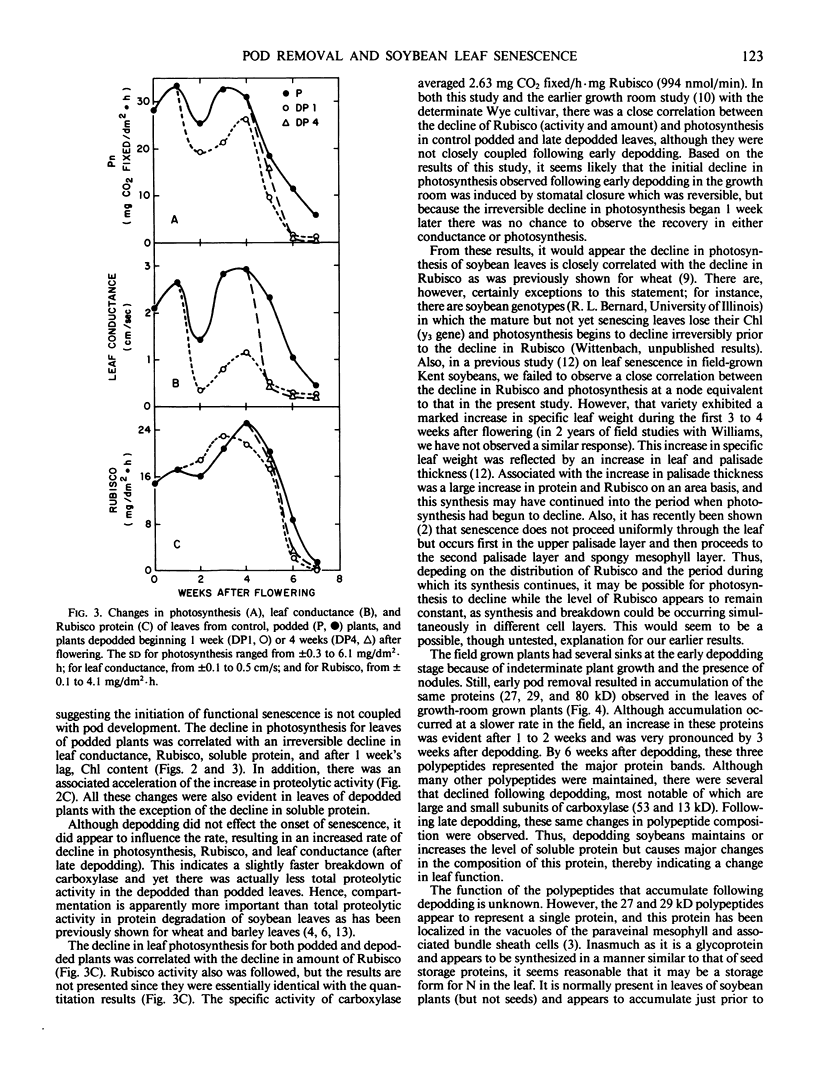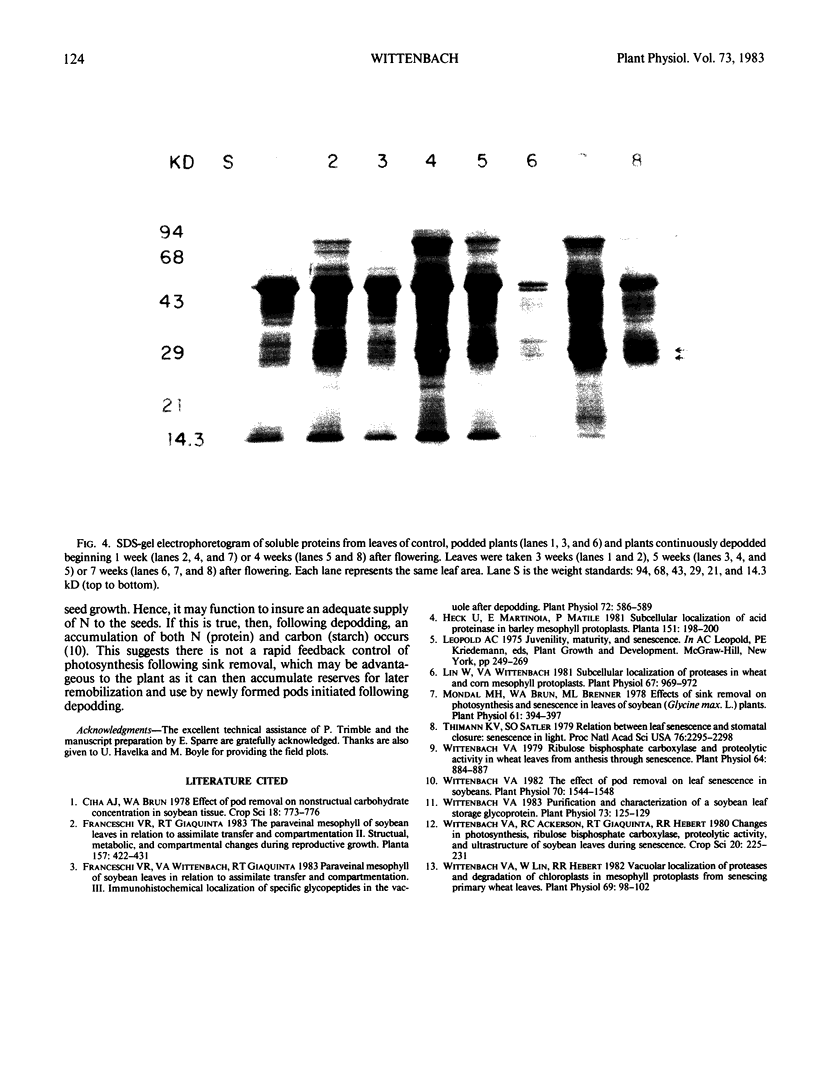Abstract
Well nodulated, field-grown soybeans (Glycine max [L.] Merr. var Williams) were depodded just prior to seed development and near mid pod-fill. Both treatments caused a considerable increase in leaf dry weight, suggesting continued photosynthate production following pod removal. Moreover, depodding had a marked effect on leaf soluble protein without affecting total proteolytic activity. Early depodding caused a 50% increase in leaf protein, and both early and late depodding caused the retention of protein for several weeks following the decline in control leaves. But despite this retention of protein, leaves of depodded plants showed no difference in the onset of the irreversible decline in photosynthesis. Therefore, although depodding delayed the loss of leaf chlorophyll and protein, it did not delay the onset of functional leaf senescence and in fact, actually appeared to enhance the rate of decline in photosynthesis. There was a good correlation between the irreversible decline in ribulose bisphosphate carboxylase (activity and amount) and that of photosynthesis. In contrast, the correlation did not seem as good between stomatal closure and the onset of the irreversible decline in photosynthesis. The reason total soluble protein remained high following depodding while carboxylase, which normally comprised 40% of the soluble protein, declined was because several polypeptides increased in amounts sufficient to offset the loss of carboxylase. This change in leaf protein composition indicates a change in leaf function; this is discussed in terms of other recent findings.
Full text
PDF



Images in this article
Selected References
These references are in PubMed. This may not be the complete list of references from this article.
- Franceschi V. R., Wittenbach V. A., Giaquinta R. T. Paraveinal Mesophyll of Soybean Leaves in Relation to Assimilate Transfer and Compartmentation : III. Immunohistochemical Localization of Specific Glycopeptides in the Vacuole after Depodding. Plant Physiol. 1983 Jun;72(2):586–589. doi: 10.1104/pp.72.2.586. [DOI] [PMC free article] [PubMed] [Google Scholar]
- Lin W., Wittenbach V. A. Subcellular localization of proteases in wheat and corn mesophyll protoplasts. Plant Physiol. 1981 May;67(5):969–972. doi: 10.1104/pp.67.5.969. [DOI] [PMC free article] [PubMed] [Google Scholar]
- Mondal M. H., Brun W. A., Brenner M. L. Effects of Sink Removal on Photosynthesis and Senescence in Leaves of Soybean (Glycine max L.) Plants. Plant Physiol. 1978 Mar;61(3):394–397. doi: 10.1104/pp.61.3.394. [DOI] [PMC free article] [PubMed] [Google Scholar]
- Thimann K. V., Satler S. O. Relation between leaf senescence and stomatal closure: Senescence in light. Proc Natl Acad Sci U S A. 1979 May;76(5):2295–2298. doi: 10.1073/pnas.76.5.2295. [DOI] [PMC free article] [PubMed] [Google Scholar]
- Wittenbach V. A. Effect of pod removal on leaf senescence in soybeans. Plant Physiol. 1982 Nov;70(5):1544–1548. doi: 10.1104/pp.70.5.1544. [DOI] [PMC free article] [PubMed] [Google Scholar]
- Wittenbach V. A., Lin W., Hebert R. R. Vacuolar localization of proteases and degradation of chloroplasts in mesophyll protoplasts from senescing primary wheat leaves. Plant Physiol. 1982 Jan;69(1):98–102. doi: 10.1104/pp.69.1.98. [DOI] [PMC free article] [PubMed] [Google Scholar]
- Wittenbach V. A. Purification and characterization of a soybean leaf storage glycoprotein. Plant Physiol. 1983 Sep;73(1):125–129. doi: 10.1104/pp.73.1.125. [DOI] [PMC free article] [PubMed] [Google Scholar]
- Wittenbach V. A. Ribulose Bisphosphate Carboxylase and Proteolytic Activity in Wheat Leaves from Anthesis through Senescence. Plant Physiol. 1979 Nov;64(5):884–887. doi: 10.1104/pp.64.5.884. [DOI] [PMC free article] [PubMed] [Google Scholar]



